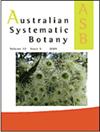澳洲昆士兰东北部特有的一新种——灰熊猫(熊猫科)
IF 1.5
3区 生物学
Q4 EVOLUTIONARY BIOLOGY
引用次数: 1
摘要
摘要大熊猫愈伤组织。,Buerki&Gallaher(Pandanaceae)是澳大利亚昆士兰东北部潮湿热带地区的一种新物种。它是除P.gemmifer H.St.John外,已知的第二个通过在地上枝条上的腋生植株繁殖的澳大利亚物种。它可以通过其叶片的尺寸、合果的形状和尺寸以及指骨的形态来与P.gemmifer和P.solms laubachii F.Muell区分开来。灰色P.grayorum在分子系统发育中的位置证实了形态学证据,并表明新物种与吉米弗P.gemmifer和劳氏P.solms-laubachii聚在一个与P.tectorius Parkinson复合体密切相关的分支中。Pandanus grayorum产于Mulgrave河、Russell河、Johnstone河和Moresby河下游以及相关的海岸下洪泛平原附近。大多数采集记录来自国家公园以外的地区,建议使用国际自然保护联盟红色名录对易危物种进行初步保护评估。最后,还提供了昆士兰东北部Pandanus物种的关键。本文章由计算机程序翻译,如有差异,请以英文原文为准。
Pandanus grayorum (Pandanaceae), a new species endemic to north-eastern Queensland (Australia)
Abstract. Pandanus grayorum Callm., Buerki & Gallaher (Pandanaceae) is newly described from the Wet Tropics of north-eastern Queensland in Australia. It is the second Australian species other than P. gemmifer H.St.John known to reproduce by axillary plantlets on aerial branches. It can be distinguished from P. gemmifer and P. solms-laubachii F.Muell. by the dimensions of its leaves, shape and dimensions of its syncarps, and by the morphology of its phalanges. The placement of P. grayorum in a molecular phylogeny confirmed morphological evidence and showed that the new species clusters with P. gemmifer and P. solms-laubachii in a clade closely related to the P. tectorius Parkinson complex. Pandanus grayorum is known from near the banks of the lower reaches of Mulgrave, Russell, Johnstone and Moresby rivers and associated subcoastal flood plains. Most collection records are from areas outside national parks and a preliminary conservation assessment of Vulnerable is suggested using the IUCN Red List. Finally, a key to north-eastern Queensland Pandanus species is also provided.
求助全文
通过发布文献求助,成功后即可免费获取论文全文。
去求助
来源期刊

Australian Systematic Botany
生物-进化生物学
CiteScore
3.10
自引率
12.50%
发文量
12
审稿时长
>12 weeks
期刊介绍:
Australian Systematic Botany is an international journal devoted to the systematics, taxonomy, and related aspects of biogeography and evolution of all algae, fungi and plants, including fossils. Descriptive taxonomic papers should normally constitute a comprehensive treatment of a group. Short papers on individual species and nomenclatural papers must contain significant new information of broader interest to be considered. The prestigious L.A.S. Johnson Review Series is published. Other review articles will also be considered. All papers are peer reviewed.
Australian Systematic Botany is published with the endorsement of the Commonwealth Scientific and Industrial Research Organisation (CSIRO) and the Australian Academy of Science.
 求助内容:
求助内容: 应助结果提醒方式:
应助结果提醒方式:


